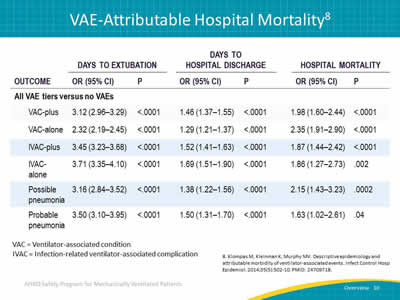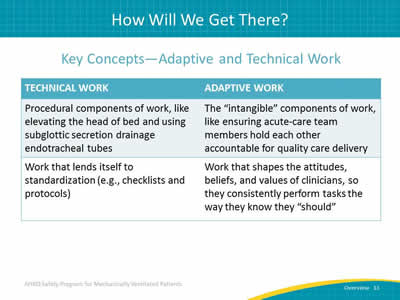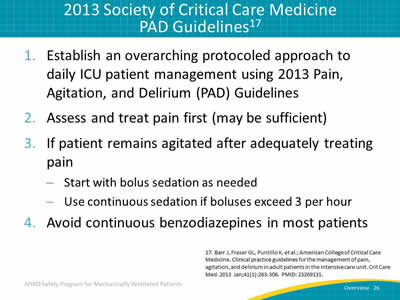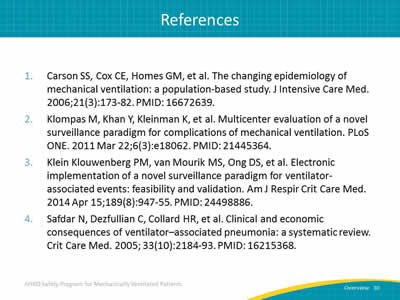Overview: Getting Patients Off the Ventilator Faster: Facilitator Guide
AHRQ Safety Program for Mechanically Ventilated Patients
Slide 1: Overview: Getting Patients Off the Ventilator Faster

Say:
In this module, we will introduce strategies and interventions, as well as adaptive and technical measures, which, when implemented, can help you get your patients off the ventilator faster. In doing so, you will effectively reduce the risk of ventilator-associated pneumonia (VAP) and other harms associated with mechanical ventilation.
Slide 2: Learning Objectives

Say:
After this session, you will be able to understand the impact of mechanical ventilation, list the interventions used in the AHRQ Safety Program for Mechanically Ventilated Patients, and provide support for the use of the recommended interventions.
Slide 3: How Do We Get Patients Off The Ventilator Faster?

Say:
How do we get the patient off the ventilator faster?
Slide 4: Margaret Mead Quote

Say:
Margaret Meade was a popular and sometimes controversial cultural anthropologist and author in the ’60s and ’70s who said, "Never doubt that a small group of thoughtful, committed citizens can change the world; indeed it is the only thing that ever has."
This quote is particularly applicable to health care today because of its continuously changing environment and the constant pressure it exerts on us to do more with fewer resources. It is sometimes difficult to see the big picture and appreciate the impact each of us has in improving patient outcomes.
Slide 5: Impact of Mechanical Ventilation

Say:
Here are some background statistics regarding mechanical ventilation:
- Eight hundred thousand patients receive mechanical ventilation in the United States each year; mechanical ventilation is a very common reason for admission to the intensive care unit.
- Five to 10 percent of mechanically ventilated patients develop a VAE.
Slide 6: Impact of Mechanical Ventilation

Say:
- Historically, many researchers considered VAP to be perhaps the most deadly healthcare-associated infection associated with mechanical ventilation.
- In fact, there is a 35 percent mortality rate for ventilated patients with VAP. Therefore, it carries significant impact for patients.
For every day a patient is on a ventilator, he or she accumulates a risk for developing a ventilator-associated event and/or VAP.
Slide 7: Impact on Mechanically Ventilated Patients

Say:
Many different complications from mechanical ventilation pose a significant burden to patients and caregivers. Examples of short-term complications include: VAP, sepsis, progression to acute respiratory distress syndrome, pulmonary embolism, barotrauma, and pulmonary edema.
Every day a patient is on the ventilator causes an increase in health care costs. On average, the ventilator charge alone in most hospitals is approximately $400 per day. In addition, being on a ventilator increases the patient’s length of stay, and is generally associated with other costs related to monitoring and support.
Some long-term complications from mechanical ventilation include slower overall recovery time, debilitating physical disabilities, lingering cognitive dysfunction, psychiatric issues such as long-term anxiety disorders, chronic depression, and post-traumatic stress disorder. All of these are associated with long intensive care unit stays and use of a mechanical ventilator.
Slide 8: Financial Impact of Mechanical Ventilation

Ask:
Have you ever considered the financial impact of mechanical ventilation?
Say:
The average intensive care unit or ICU cost for a ventilated patient is $2,300 per day, and that cost rises to more than $3,900 per day after the fourth day. If the ventilator days were reduced by just 20 percent, patient throughput would increase, increasing revenue and allowing staff to care for more patients.
Slide 9: Defining Ventilator-Associated Events

Say:
Previous VAP surveillance definitions were subjective and non-reproducible. Over the last few years, the Centers for Disease Control and Prevention or CDC has redefined these into what we call ventilator-associated events, or VAEs, which are identified with a combination of very objective criteria:
- Deterioration and respiratory status after a period of stability or improvement on the ventilator.
- Evidence of infection or inflammation, and then,
- Adding in laboratory evidence of respiratory infection.
These criteria or a combination of these criteria define the different tiers we see within the ventilator-associated event structure.
Slide 10: VAE-Attributable Hospital Mortality

Say:
A retrospective cohort study conducted between 2006 and 2011 at an academic tertiary care center calculated and compared VAE hazard ratios, antibiotic exposures, microbiology, attributable morbidity, and attributable mortality for all VAE tiers.
Compared with matched controls, VAEs were associated with more days to extubation, more days to hospital discharge, and higher hospital mortality risk. The overall conclusion was that VAEs are common and morbid and that prevention strategies targeting VAEs, such as the program you are learning about now, are needed.
Slide 11: What Do We Need To Do?

Say:
The care provided to mechanically ventilated patients has improved tremendously over the past 10 years. We have a much clearer view about the therapies these patients should be receiving to decrease the short-term and long-term complications of mechanical ventilation and to improve patient and family experience. Interventions to improve patient outcomes and reduce complications focus on the importance of getting patients off the ventilator faster and getting them out of the ICU safely and faster. Reducing the exposure to mechanical ventilation is likely our most powerful strategy for reducing the complications associated with mechanical ventilation and critical illness. From the perspective of leadership and hospital administration, there is an increasing focus on improving efficiency while reducing costs.
Slide 12: AHRQ Safety Program Goals
![To reduce risk of patient harms associated with mechanical ventilation: Reduce ventilator-associated events, including VAP (Centers for Disease Control and Prevention [CDC] definition of VAEs). Reduce the duration of mechanical ventilation, length of stay, and mortality. To achieve significant improvements in teamwork and safety culture in ICUs.](/sites/default/files/wysiwyg/professionals/quality-patient-safety/hais/tools/mvp/modules/vae/ptsoffventilator/ptsoffventilator-slide12.jpg)
Say:
The two main safety program goals are: (1) reduce the risk of patient harms associated with mechanical ventilation and (2) achieve significant improvements in teamwork and safety culture in ICUs. By getting patients off of the ventilator faster, you will reduce the risk of patient harms associated with mechanical ventilation. In addition, you will reduce the number of ventilator-associated events and the duration of mechanical ventilation, ICU and hospital length of stay, and mortality. By improving teamwork and safety culture, you will have more success in reaching the first goal.
Slide 13: How Will We Get There?

Say:
Throughout these modules, we will discuss the adaptive and technical work involved in getting patients off the ventilator faster.
The technical piece consists of the procedural components of work, like elevating the head of bed and using subglottic secretion drainage endotracheal tubes. It focuses on tasks and lends itself to various forms of standardization like checklists and protocols. These evidence-based interventions lead to patient safety and quality methods and processes. However, leading successful technical change requires adaptive work.
Adaptive work consists of the "intangible" components of work, like ensuring acute-care team members hold each other accountable for quality care delivery. Local culture is simply, "The way we do things around here." It is the collection of local attitudes, beliefs, and values of clinicians that enable them to perform the tasks or technical interventions the way they know they "should." Making permanent changes in technical work or the way they do things can only be addressed through changes in clinicians’ priorities, beliefs, habits, and loyalties.
Slide 14: Building on Previous State-Level Success…

Say:
The Comprehensive Unit-based Safety Program, or CUSP, builds on the lessons learned from previous successful statewide efforts, including the Michigan Keystone ICU program to improve culture and reduce healthcare-associated infections.
The Michigan Keystone intensive care unit program was a multifaceted quality-improvement program that included a checklist to help ensure that providers complied with evidence-based recommendations for the prevention of two common health care-associated infections: central line-associated blood stream infections, referred to as CLABSIs, and VAP. They achieved a 66 percent reduction in CLABSIs and a 71 percent reduction in VAP in more than 100 Michigan intensive care units. Mortality rates and health care costs were decreased while safety climate and patient outcomes improved.
Slide 15: …and National-Level Highlights

Say:
CUSP also builds on the lessons learned from the National On the CUSP: Stop BSI program. That program included more than 1,000 ICUs across 44 States and was associated with a 43 percent reduction in CLABSI rates. While many organizations had been working on reducing CLABSI for years, the number of participating ICUs that achieved zero CLABSI rates for a quarter more than doubled during the program.
Slide 16: Ventilator-Associated Events Successes

Say:
After the definitions of VAEs were released, there was concern that these complications may not be preventable. That concern was addressed in 2015 with the release of results from the CDC Prevention Epicenters’ Wake Up and Breathe Collaborative, a VAE prevention prospective quality improvement study. Twelve ICUs affiliated with seven hospitals sought to decrease VAEs by decreasing sedation levels and the duration of mechanical ventilation. They focused on enhancing the performance of paired daily spontaneous awakening trials (SATs) and spontaneous breathing trials (SBTs).
Slide 17: Ventilator-Associated Events Successes

Say:
Over a 19-month period, they observed a substantial increase in SATs and SBTs which in turn was mirrored by substantial decreases in ventilator-associated conditions (VACs) and infection-related ventilator associated conditions (IVACs). SATs and SBTs were coupled and had profound benefits; they woke up patients every day and stopped or minimized their sedation so the patients could then participate in a spontaneous breathing trial. What they found is that through this collaborative process, they were able to increase the number of spontaneous awakening trials by 63 percent. They were able to increase spontaneous breathing trials by 16 percent. And, they were able to substantially improve the rate of spontaneous breathing trials being done with sedatives off.
Consider that when patients fail spontaneous breathing trials, it is often because the patients were still too sedated. As a result, they are not able to effectively participate during a spontaneous breathing trial, which can lead to greater duration of mechanical ventilation. If heavy sedation is reduced and you can achieve, for example, RASS scores of zero to negative one such that patients can participate and pass a spontaneous awakening trial, and then effectively do a spontaneous breathing trial, you can get the patient off the ventilator faster.
By linking SATs and SBTs together and finding these improvements in the processes of care, this collaborative was able to decrease vent days by 2.4 days, reduce ICU length of stay by 3 days, and decrease their total hospital length of stay by 6.3 days. In addition, there was a 37 percent reduction in VAC and a 65 percent reduction in IVACs.
Slide 18: Interventions

Say:
We will now review the interventions included in this project.
Slide 19: Interventions

Say:
In this program, we implement four main interventions designed to improve the care of mechanically ventilated patients.
The first intervention is the use of CUSP, the Comprehensive Unit-based Safety Program. CUSP comprises five tenets, which will be reviewed later, designed to improve the safety culture of health care organizations. Adaptive or cultural, behavioral changes are required to effectively put the technical components of protocols, procedures, and other interventions in place. Knowing simply how to develop a checklist, for example, is quite different from putting that checklist in place and having teams accept it and use it every day. CUSP aims to provide strategies that support adaptive work so that technical efforts can be successful.
The second intervention is the use of evidence-based daily care processes such as the use of subglottic secretion drainage endotracheal tubes, elevating the head of the patient’s bed to at least 30 degrees, the minimization of sedation, delirium assessment, and the use of coordinated spontaneous breathing trials and spontaneous awakening trials.
The third intervention is promoting early mobility by tailoring individual patient goals to maximize mobility, as well as again minimizing sedation and assessing delirium.
The final intervention is low tidal volume ventilation. Following recommendations for low tidal volume ventilation—using a volume of 6-8 cc/kg predicted body weight for patients without ARDS and 4-6cc/kg predicted body weight for patients with ARDS, plateau pressure of less than or equal to 30 cm H2O, and the use of positive end-expiratory pressure instead of zero end-expiratory pressure—can prevent further pulmonary complications.
Slide 20: Intervention 1—CUSP

Say:
CUSP is a five-step process.
The first step is to educate staff on the Science of Safety and to help teams develop lenses to focus on system factors that can negatively impact care. When we develop lenses that allow us to see those system factors and how they influence care, we can see the risks of patient harm that exist within our clinical area.
The second is identifying defects. A defect is anything that can happen clinically or operationally that you do not want to happen again. It is an unsafe condition. It could be a patient fall, a venous thromboembolism, a medication error, ventilator associated pneumonia, or anything that can lead to preventable patient harm. Ask these questions: "How will the next patient in your clinical area be harmed? What can be done to minimize this harm? How can we get the patient off of the ventilator faster?"
The third step is to partner with a senior executive. Encourage the senior partner to attend rounds. Having leadership involvement in CUSP efforts is critical. Work with a senior executive to develop a shared understanding of local defects. Include a senior executive as an active member of the CUSP team who will partner with the frontline staff. A senior executive will help ensure that the team has access to resources to support their implementation efforts and that their efforts are aligned with the goals of the health care organization.
In the fourth step, teams learn a process through which they can learn from the defects that occur in their clinical area.
Throughout this CUSP process, teams will improve teamwork and communication. All of these are adaptive components within CUSP.
Slide 21: Intervention 2—Daily Care Process Measures

Say:
Daily care process measures consist of several interventions.
One is the use of subglottic secretion drainage endotracheal tubes in all patients that are expected to be ventilated for greater than 72 hours. Subglottic secretion drainage endotracheal tubes are an effective tool for reducing VAP and getting patients off the ventilator faster.
Another intervention is to elevate the head of bed into a semi-recumbent position of at least 30 degrees.
Minimizing the sedation level and awakening the patient so that they can participate in spontaneous breathing trials will also help to decrease the duration of mechanical ventilation. Another process measure involves the use of spontaneous awakening trials using a validated scale for sedation such as the RASS score and the SAS (Riker Sedation-Agitation Scale).
In addition, assessment of readiness to wean using daily spontaneous breathing trials can reduce the duration of mechanical ventilation. Linking SATs and SBTs together becomes a very powerful and effective tool for getting patients awake, breathing, and assessing them for extubation and vent removal.
Finally, assess for delirium and control delirium. Patients who are delirious in the ICU can become very agitated; it becomes very difficult to get them off the vent quickly. In addition, delirium can be mistaken for anxiety, and incorrectly treated with sedation. Be aggressive about identifying delirium through the processes of care, using effective delirium scales, and having a well thought out and well-applied plan to control the delirium.
Combining all of these pieces/tools can have a powerful impact on getting patients off the ventilator faster.
Slide 22: Intervention 3—Daily Early Mobility

Say:
The barriers to daily early mobility interventions can be overcome by using a multidisciplinary approach, getting all of the stakeholders involved, and employing a nurse-driven protocol that collaborates with physical, occupational, and respiratory therapists. It also entails minimizing sedative use and utilizing daily interruptions of sedation as well as screening for eligibility for mobilization.
There are many different levels of improving a patient’s ability to exercise, move their muscles, and engage in some sort of mobility. For example, someone can use a bicycle ergometer in bed if they cannot get up, move, and walk around.
Tailor patient goals to improve the functionality and mobility of patients to at least some level of mobility. Every incremental improvement is to be applauded and will boost the morale of the patient and their loved ones.
Maximizing mobility is an opportunity for families to get involved in helping to improve the patient’s care while on a ventilator. While families do not have a role, for example, in the placement of a subglottic secretion drainage endotracheal tube, they can be tremendous partners in improving the patient’s mobility by helping to work with them while they are in the ICU.
Slide 23: Intervention 4—Low Tidal Volume Ventilation

Say:
Low tidal volume ventilation is an important intervention to prevent acute respiratory distress syndrome (ARDS) or further damage in those who have ARDS. To do so, use positive end-expiratory pressure greater than or equal to 5cm H20, not zero end-expiratory pressure (ZEEP), maintain plateau pressure at less than or equal to 30cm H20, and use tidal volume of 6-8 cc/kg predicted body weight in patients without ARDS, or 4-6cc/kg in patients with ARDS.
Slide 24: 2014 SHEA Compendium Update

Say:
The interventions needed to reduce the duration of mechanical ventilation are well supported by the evidence cited in the document from the 2014 Society for Healthcare Epidemiology of America (SHEA) Compendium Update. Some of the interventions the organization advocates are: elevate the head of the bed to 30-45 degrees, use subglottic secretion drainage endotracheal tubes for patients who will be intubated for more than 48 to 72 hours, and manage ventilated patients without sedation whenever possible.
Slide 25: 2014 SHEA Compendium Update

Say:
If sedation is necessary, interrupt sedation at least once a day and assess the patient's readiness to breathe and readiness to extubate, while pairing spontaneous breathing trials with spontaneous awakening trials. In other words, conduct a spontaneous breathing trial with the patient off of all sedatives. The SHEA Compendium also advocates for the employment of early mobility and exercise and the use of noninvasive positive pressure ventilation whenever feasible.
Slide 26: 2013 Society of Critical Care Medicine PAD Guidelines

Say:
Another document that supports the evidence of these interventions comes from the 2013 Society of Critical Care Medicine (SCCM) PAD guidelines. The SCCM guidelines advocates for an establishment of an overarching protocoled approach to daily ICU patient management using the 2013 Pain, Agitation, and Delirium (PAD) guidelines. It ensures that we have a standardized approach to assess and treat pain first.
For many patients, this may be sufficient. If the patient continues to be agitated after adequately treating pain, initiate as needed boluses of sedation as needed and attempt to avoid continuous sedative drips. Use continuous sedation if boluses exceed three per hour. However, the SCCM guidelines advocate for the avoidance of continuous benzodiazepine use in most ventilated patients.
Slide 27: 2013 Society of Critical Care Medicine PAD Guidelines

Say:
The fifth recommendation is to turn off sedation daily and restart only if needed at the lowest dose to maintain a chosen target level of consciousness. Avoid deep sedation with a Richmond Agitation Sedation Scale (RASS) of -4/-5, as it appears to be harmful.
Alternatively, target having an awake and alert patient. Screen for delirium using a validated tool like the Confusion Assessment Method (CAM-ICU) or ICDSC. If delirious, first seek reversible causes and attempt non-pharmacologic management.
Finally, use the ABCDE bundle to improve outcomes for your patients. The ABCDE Bundle is an intervention that combines the following: Awakening and Breathing coordination, Choosing light sedation, Delirium monitoring and management, and Early mobility.
Slide 28: ABCDEF Bundle

Say:
The ABCDEF bundle summarizes the intervention process of coordinating spontaneous awakening and spontaneous breathing trials, and choosing light sedation to get people off the ventilation faster. The process of delirium management is a means to control sedation levels so we can move patients faster to the ABCs.
The term early mobility has been expanded to include early exercise. Not every patient can reach the pinnacle of early mobility, ambulation, but every increase in range of motion and/or vigorous activity that a patient can engage in—in a bed or on a ventilator—can help improve their overall care and get them off the ventilator faster.
The last, and newest, component is "F," which stands for family and patient involvement. This is a resource that is too often overlooked. Families and patients have the opportunity to get involved and become partners in the process of improving care, which benefits both the patient and the family members. Combining all six of these interventions can effectively reduce ventilator associated events, reduce the duration of mechanical ventilation, and improve both the short-term and long-term outcomes that can be devastating for patients who are mechanically ventilated while in the ICU.
Slide 29: Questions?

Slide 30: References

Slide 31: References

Slide 32: References

Slide 33: References

Slide 34: References




